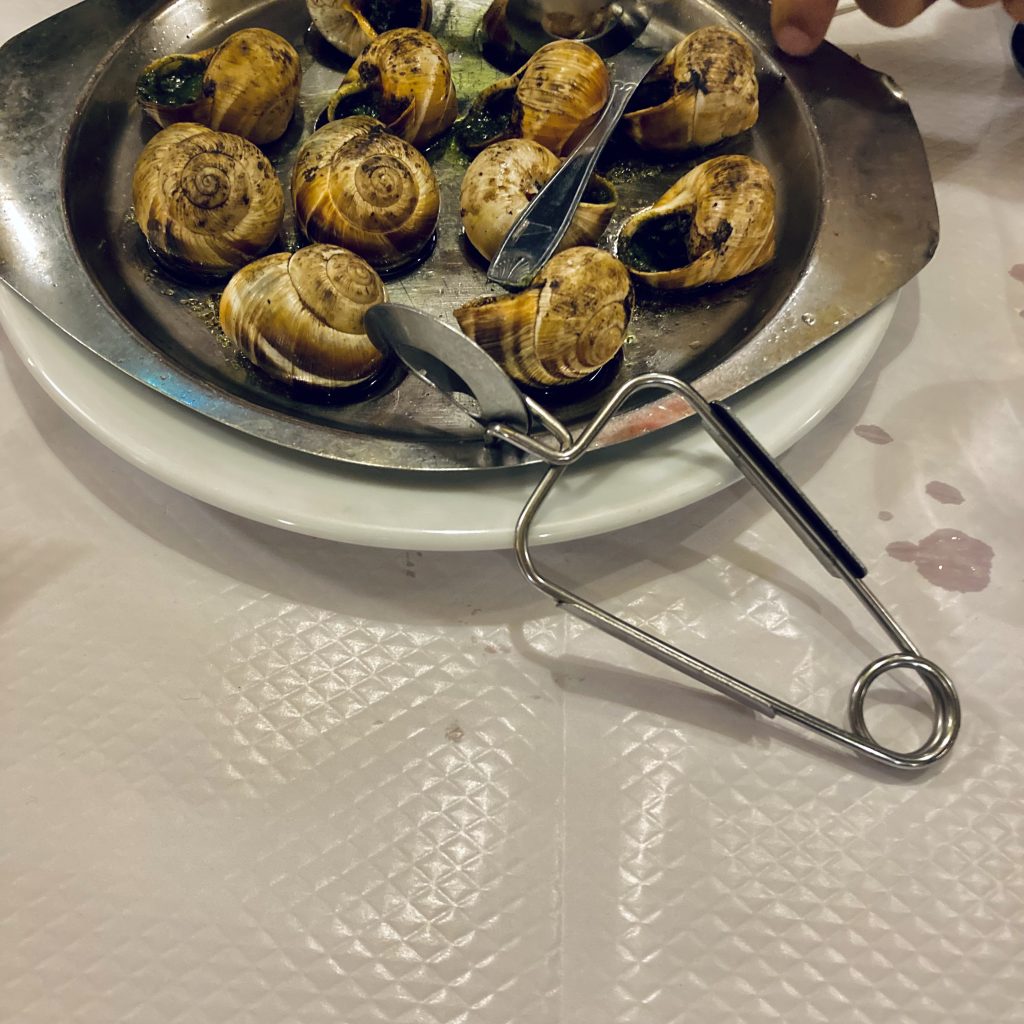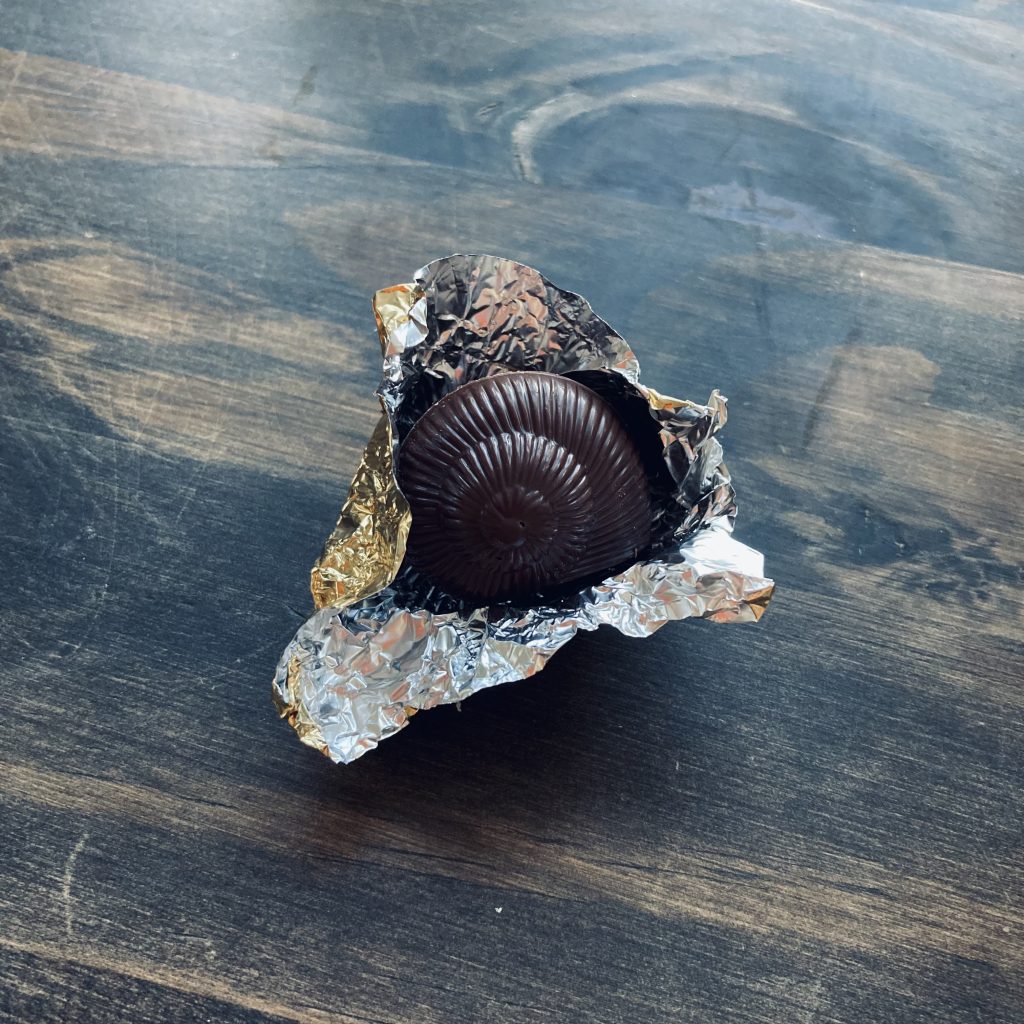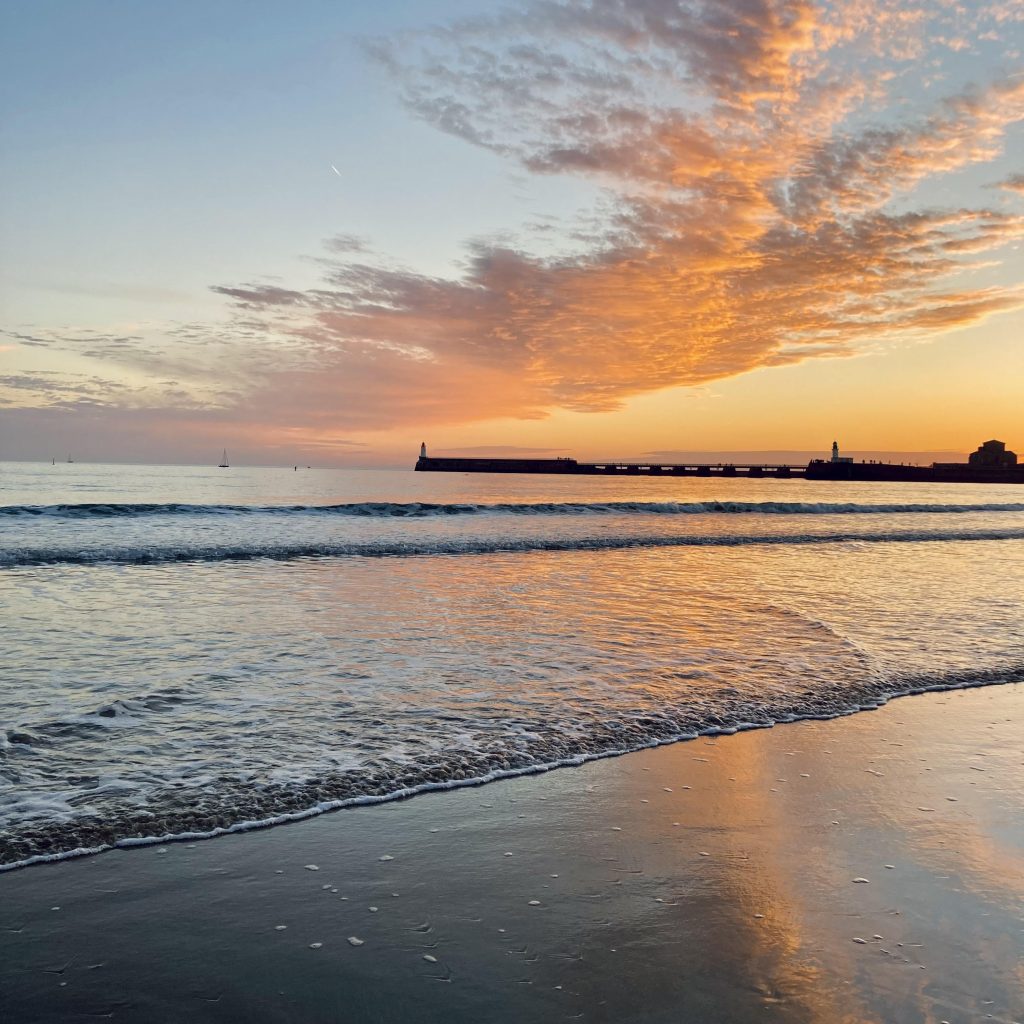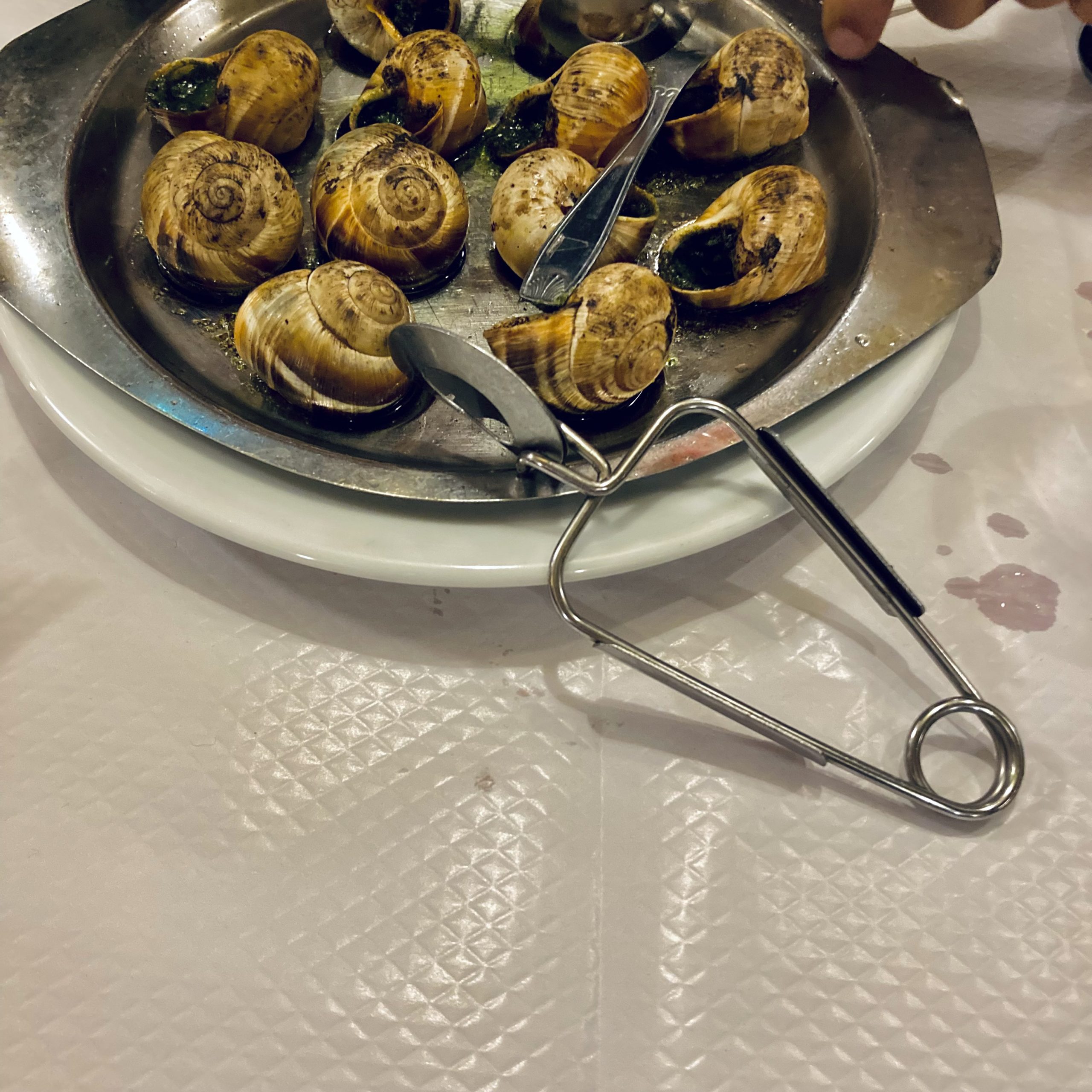‘Je déclare sur l’honneur n’avoir présenté, au cours des dernières 48 heures, aucun des symptômes suivants…’ I drop my signature at the bottom of the page dutifully so I can cross the border between the United-Kingdom and France. On the train, two American women comment on the skyline of NYC, the Eurotunnel, a humming noise in my ears and the conductor announces metro tickets can be purchased at the bar. Twenty-two months have blurred together in the blink of an eye, catching sight of Calais, the prevailing music slogan of the SNCF makes me smile as soon as I arrive in Gare du Nord.
When I was a child, growing up on the northern outskirts of Paris, where high-rise buildings and woodlands meet, I collected snails in a shoe box. A mollusc and gastropod, snails were the first animal to move on land, departing from their cousins the oysters and the mussels. One of the most diverse species on the planet, snails can be found in all habitats from oceans to deserts. The ones I kept close once must have been garden snails, the Helix aspersa: soft body inside a light yellow-coloured shell, darker spiral stripes, this air-breathing mollusc retracts in its shell when it’s not feeding or when it feels in danger.
After a short walk in the direction of the Grands Boulevards, a nonchalant man shepherds me and my boyfriend into a waiting line. He scans our green passes. He follows the rumour of my lips behind my face mask while my voice is shy, untangling my tongue with the French language, his two fingers pointing up and an authoritative voice speaking through a walkie-talkie. I’ve taken L. on his first trip to Paris so we are patient, eyeing the sign that advertises Sangria for 1 euro and dropping ears as the couple behind us fights hungrily. People scroll their phones, face coverings shadowing their breathing patterns, their eyes glittering as they squint before the blue light. We move forward, slowly, through the lobby and back outside towards the courtyard, a carousel door between us and the promise of an authentic Parisian lunch. Bouillon Chartier is written in cursive letters at the top.
We enter: boiling song of chatters, high ceiling, cramped dark wooden tables and long mirrors on each side. We’re shown our table and I’m asked to remove my handbag from the chair next to me; another pair joins us. The two men sit, we nod at each other; one bread basket, one carafe of water, four menus. A waiter arrives to greet us, dressed in a long and white apron, he takes a note of our order straight on the paper tablecloth. L. mentions the rails on the side-walls of the dining room – ‘like the ones in trains’, he adds. They were built to store visitors’ bags because the floor is preserved for the garçons to run faster.
We order 12 escargots to share immediately – the overwhelming smell of parsley, garlic and butter – the small pieces of meat sneaking in between our hands. The texture of overcooked chestnut mushrooms, the smell of falling leaves after the rain, the woodlands of Paris. I use pliers to grab the first shell but I abandon them for the feeling of my fingers, my pace fastening, gulping. I exhale, lick the tips of my fingers, and I reach for a piece of baguette to mop the buttery sauce, six escargots to welcome me back.
Lunchtime, for twelve escargots:
2 garlic cloves, thinly chopped
50g salted butter at room temperature
1 bunch of fresh flat-leaf parsley, thinly chopped
40ml dry white wine
12 canned snails
s&p to taste
To serve:
12 escargot shells or bread, cut in 12 small slices
Preheat the oven to 200C fan. In the meantime, reduce the garlic into a paste with the help of a mortar. Add salt to taste (consider the butter is salted already), parsley and butter. Beat well until combined. Incorporate the wine slowly, mixing as you go.
Stuff one snail into each shell and top it up with the garlic butter. If you don’t have serving shells, spread the garlic with a snail on top of each slice of bread. Bake for 5 minutes or until butter is melted.

The Helix pomatia, or commonly known as Escargot de Bourgogne, is the popular edible snail as well as one of Europe’s biggest species of terrestrial snails. Its shell is slightly clearer, a creamier colour ready to take butter for a spouse, six whorls and a large aperture to welcome garlic and parsley. When snails forage for food, a slime trail follows their path, the secretion allowing them to progress on land while the trail is then used as a navigation guide. Snails hibernate in winter, escaping the cold temperatures, hiding in the same hole where they lay eggs. They retract into their shell and they seal the season by releasing mucus to cover the shell’s top opening.
A shade of raspberry jam colours her lips, flawless brushing, the tip of her hair caressing her shoulders, Mamie opens the door. I follow her eyes as they take measure of how much time has passed along with the colour of my eyes. Paulette disregards our mounting tears and she walks to the kitchen, her mint pencil skirt pacing her steps, family photos pinned with outdated magnets on the fridge door at the end of her race. She waves a bottle of champagne at me – the golden cork cover glitters her pupils – and she invites us to sit at her table. White tablecloth, flutes and a pear and chocolate tart are staged, more family photos, but framed this time, are scattered around the living room. Paulette loves champagne. She asks questions, slows down to listen to some of the answers and drifts away from others. There is not enough time, different opinions and our two worlds clash as bubbles sparkle and we refill our glasses. Mamie starts to tell stories soon after, recalling travels with her first car all the way to England, driving on the wrong side of the road after a sickening journey on the ferry. The wrong side because Paulette is always right. There is little to say about 2021, but so much to remember from her life, the grandfather and the brother I never met, the summer she spent sailing south of the English coast.
When I was in primary school, Mamie came to pick me up at the end of the day. Her Renault21 car was always parked in the same spot, the seats wrapped in carpet-like material, a small mosaic design covering the fabric. She ended each school day with a lipstick mark on my left cheek, a bottle of water and grenadine and a pain au lait with chocolate spread inside. She turns the finished bottle of champagne upside down and I exit her home, leaving her behind, a single lipstick mark on her glass.
She calls me on the phone a few minutes later: ‘I forgot to give you your chocolates’, she says, disappointed with herself. I turn around and find that she is waiting for me in the parking lot, a golden-coloured box in her hands.
Goûter with Mamie Paulette:
one box of Escargots de Lanvin
Unwrap the crispy paper and find an escargot with a heart made of praline inside. Repeat as many times as necessary, pairing with the beverage of your choice.

Also from Bourgogne and created in 1934, L’escargot de Lanvin is a snail shaped chocolate whose shell is filled with a rich and smooth hazelnut praline. Each chocolate is dressed with a golden paper, foil inside for preservation. France, the land of butter and sweets, memories and childhood, a country where I returned at a snail pace after the border between France and England reopened, the fear of disappointment and not knowing what it is like anymore. Home, as it’s referred to so often.
Then comes the ocean, in a burst of tides and wind gusts, the Atlantic toying with clouds along the coast of Vendée where my mother lives. We share a dinner with other members of the family in La Chaume, the village on the other side of the estuary of Les Sables d’Olonne, where fishermen lived before their jobs became rarer and retired metropolitans drove housing prices high. We go to the wholesaler on the edge of the wild coast: sea marches, wildflowers and itchy eyes, seafood is sold in crates that are dipped in sea water, the lyric of crackling shells after each handful is drawn. All kinds of fish swim and soles play hide and seek at the bottom of the seawater pools. Posters about marine wildlife hung on the walls, raincoats lay on the barriers to dry, our questions echo within the aquamarine blue tiles.
There are family stories and boats that are named after superstitions and memories – and I had missed hearing about them, all these clues I steal in between two conversations, the gift of walking somewhere that has a shared history with the one of my name. We buy oysters, langoustines and sea snails while the governments of France and the United-Kingdom continue to fight about fishing regulations, waste as a result, the moon dictating sea levels nonetheless.
Dinnertime, homecoming with sea snails:
a handful of periwinkles
a bunch of thyme and bay leaves, tied together
1 shallot, peeled and cut in half
1 cube of fish stock
coarse sea salt
pepper
Soak the periwinkles in cold water for 10 minutes. Rinse and repeat once. Place the clean periwinkles in a pot, add the thyme, bay leaves and shallot, and crumb the fish stock. Cover with water, add salt and pepper to taste and turn the heat up. As soon as the water boils, turn off the heat and leave aside until the water has cooled down. Drain, reserve the stock for another day and pick the sea snails out from their shells.

The periwinkle – one of a kind under the umbrella appellation ‘sea snails’ – is an intertidal, slow-moving gastropod mollusc of small size and is harvested worldwide. The resistant shell of sea snails, made to survive the depth of oceans, means that they’re often found in fossil records where they testify of the tides’ calendar, storms and water temperatures, their shell development inevitably affected by their environment.
Locator form, day-2 test, I’ve returned to London with a heavy suitcase dragging behind me, a box of Escargots de Lanvin chocolates packed inside and my hair thinned after I was exposed to the saline air. Garden snails venture in humid weather, on mild rainy days or at nighttime, sliding underneath their shell, a shelter at threat of cracking at each faux pas, their home subjected to the whims of time. A purple line appears – negative result – and I set the pace to my local grocer in North London. Low winter sky and dense blue air, I walk slowly, seizing my environment: Margaux l’escargot was my nickname when I was a child and tomorrow, I’ll melt butter, garlic and parsley in my kitchen.
Margaux, November 2021


